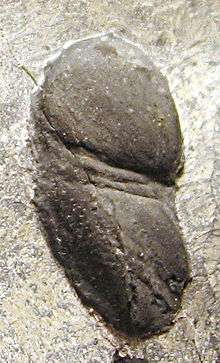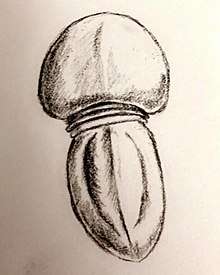Tariccoia
Tariccoia is a genus of small to average size (between 2.5 centimetres (0.98 in) and 6 centimetres (2.4 in) long) marine arthropods in the Liwiidae Family, that lived during the late Ordovician period.[1] Fossil remains of Tariccoia were collected from Sardinia, Italy. Tariccoia looks like a large, soft agnostid trilobite. It has a headshield (or cephalon) wider than the tailshield (pygidium), and in between them three (or four?) thoracic body segments (somites). The genus is monotypic, its sole species being Tariccoia arrusensis.
| Tariccoia arrusensis | |
|---|---|
 | |
| Tariccoia arrusensis, 21 mm, from Sardegna, Italy | |
| Scientific classification | |
| Kingdom: | |
| Phylum: | |
| Order: | |
| Family: | |
| Genus: | †Tariccoia |
| Species: | †T. arrusensis |
| Binomial name | |
| Tariccoia arrusensis Hammann, 1990 | |
Etymology
The name of the genus references the Sardinian paleontologist M. Taricco. The species was named after the Riu is Arrus Member, the deposit in which it was found.[1]
Description

Tariccoia arrusensis is between 2.5 and 6 cm along the axis,[2] almost half a wide as long. The dorsal exoskeleton consists of a cephalon, a pygidium and two or three thoracic somites with articulating half-rings, all non-calcified. The cephalon is sub-semicircular, widest near the rounded genal angles. The cephalon is wider than the pygidium. Eyes are absent. Antennas are not known. The body is constricted at the two or three thoracic somites, so the animal gives the impression to have a waist. The pygidium is widest before midlength. The pygidium has a mid-ridge.[1]
Differences with other Liwiidae
- Tariccoia arrusensis differs from Liwia by having 3 clearly visible thoracic somites (perhaps a 4th is obscured by the cephalon) instead of 4. T. arrusensis has a mid-length ridge on the pygidium, which is not known from Liwia. Tariccoia also has an oval pygidium with an entire margin, while Liwia has five pairs of modest marginal spines, a straight anterior border and a concave posterior border.
- T. arrusensis differs from Buenaspis forteyi, that has a cephalon and pygidium that are not wider than its 6 thoracic somites. The pygidium of B. forteyi is wider than long, with a straight anterior border. Buenaspis and Tariccoia have an entire margin and a mid-ridge on the pygidium in common.
- T. arrusensis differs from Soomaspis splendida, that has an oval cephalon, and lacks visible segmentation of the pygidium. Tariccoia and Soomaspis both have a broad doublure and lack a lengthwise mid-ridge on the cephalon. In both species the pygidium is about as long as wide, but in Soomaspis the widest point is around midlength, while Tariccoia is widest in the frontal half. The species share 3 thoracic somites, an entire margin and a mid-ridge on the pygidium.[3]
Distribution
T. arrusensis has been collected from the Upper Ordovician (Sandbian to Katian) Riu is Arrus Member, Monte Argentu Formation, Sardinia, Italy.[1]
Habitat
Tariccoia arrusensis was probably a marine bottom dweller.
References
- W. Hammann, R. Laske & G. L. Pillola (1990). "Tariccoia arrusensis n. g. n. sp., an unusual trilobite-like arthropod. Rediscovery of the "phyllocarid" beds of Taricco (1922) in the Ordovician "Puddinga" sequence of Sardinia". Bolletino della Societa Palaeontologica Italiana. 29: 163–178.
- L. Ramskold, J.-Y. Chen, G.D. Edgecombe, and G.-Q. Zhou ( 1996). Preservational folds simulating tergite junctions in tegopeltid and naraoiid arthropods. Lethaia 29:15-20. ISSN 0024-1164.
- E. Bonino & C. Kier (2010). The Back to the Past Museum Guide to Trilobites. pp. 18–19, fig. 9.